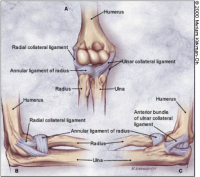Elbow Valgus Stress: Difference between revisions
mNo edit summary |
Evan Thomas (talk | contribs) mNo edit summary |
||
| Line 2: | Line 2: | ||
'''Original Editor '''- [[User:Tyler Shultz|Tyler Shultz]] | '''Original Editor '''- [[User:Tyler Shultz|Tyler Shultz]] | ||
'''Lead Editors''' | '''Lead Editors''' | ||
</div> | </div> | ||
== Purpose | == Purpose == | ||
The elbow valgus stress test is used to assess the integrity of the medial collateral ligament, also known as the ulnar collateral ligament.<br> | The elbow valgus stress test is used to assess the integrity of the medial collateral ligament, also known as the ulnar collateral ligament.<br> | ||
| Line 11: | Line 11: | ||
[[Image:Elbow_Ligaments.png|thumb|right|200px|Elbow Ligaments]] | [[Image:Elbow_Ligaments.png|thumb|right|200px|Elbow Ligaments]] | ||
== Technique | == Technique == | ||
This test can be performed with the patient supine, sitting, or in the standing position. The therapist places the patients elbow in approximately 20 degrees of flexion while palpating the medial joint line and stabilizing the distal humerus with one hand and applying a valgus stress to the elbow with the other hand.<ref>Flynn, T.W., Cleland, J.A., Whitman, J.M. (2008). User's guide to the musculoskeletal examination: Fundamentals for the evidence-based clinician. Buckner, Kentucky: Evidence in Motion</ref><ref>Dutton, M. (2008). Orthopaedic: Examination, evaluation, and intervention (2nd ed.). New York: The McGraw-Hill Companies, Inc.</ref> The test is considered positive if the patient experiences pain or excessive laxity is noted compared to the contralateral side.<ref>Flynn, T.W., Cleland, J.A., Whitman, J.M. (2008). User's guide to the musculoskeletal examination: Fundamentals for the evidence-based clinician. Buckner, Kentucky: Evidence in Motion</ref> As with the [[Elbow Varus Stress|varus stress test]], this test can be repeated in varying degrees of elbow extension to test different portions of the MCL.<ref>Dutton, M. (2008). Orthopaedic: Examination, evaluation, and intervention (2nd ed.). New York: The McGraw-Hill Companies, Inc.</ref><br><br> | This test can be performed with the patient supine, sitting, or in the standing position. The therapist places the patients elbow in approximately 20 degrees of flexion while palpating the medial joint line and stabilizing the distal humerus with one hand and applying a valgus stress to the elbow with the other hand.<ref>Flynn, T.W., Cleland, J.A., Whitman, J.M. (2008). User's guide to the musculoskeletal examination: Fundamentals for the evidence-based clinician. Buckner, Kentucky: Evidence in Motion</ref><ref>Dutton, M. (2008). Orthopaedic: Examination, evaluation, and intervention (2nd ed.). New York: The McGraw-Hill Companies, Inc.</ref> The test is considered positive if the patient experiences pain or excessive laxity is noted compared to the contralateral side.<ref>Flynn, T.W., Cleland, J.A., Whitman, J.M. (2008). User's guide to the musculoskeletal examination: Fundamentals for the evidence-based clinician. Buckner, Kentucky: Evidence in Motion</ref> As with the [[Elbow Varus Stress|varus stress test]], this test can be repeated in varying degrees of elbow extension to test different portions of the MCL.<ref>Dutton, M. (2008). Orthopaedic: Examination, evaluation, and intervention (2nd ed.). New York: The McGraw-Hill Companies, Inc.</ref><br><br> | ||
| Line 20: | Line 20: | ||
Provide the evidence for this technique here | Provide the evidence for this technique here | ||
== References == | |||
== References | |||
<references /> | <references /> | ||
[[Category:Special_Tests]] [[Category:Elbow]] [[Category:Ligaments]] [[Category:Musculoskeletal/Orthopaedics]] | |||
Revision as of 07:14, 6 December 2017
Original Editor - Tyler Shultz
Lead Editors
Purpose[edit | edit source]
The elbow valgus stress test is used to assess the integrity of the medial collateral ligament, also known as the ulnar collateral ligament.
Technique[edit | edit source]
This test can be performed with the patient supine, sitting, or in the standing position. The therapist places the patients elbow in approximately 20 degrees of flexion while palpating the medial joint line and stabilizing the distal humerus with one hand and applying a valgus stress to the elbow with the other hand.[1][2] The test is considered positive if the patient experiences pain or excessive laxity is noted compared to the contralateral side.[3] As with the varus stress test, this test can be repeated in varying degrees of elbow extension to test different portions of the MCL.[4]
Evidence[edit | edit source]
Provide the evidence for this technique here
References[edit | edit source]
- ↑ Flynn, T.W., Cleland, J.A., Whitman, J.M. (2008). User's guide to the musculoskeletal examination: Fundamentals for the evidence-based clinician. Buckner, Kentucky: Evidence in Motion
- ↑ Dutton, M. (2008). Orthopaedic: Examination, evaluation, and intervention (2nd ed.). New York: The McGraw-Hill Companies, Inc.
- ↑ Flynn, T.W., Cleland, J.A., Whitman, J.M. (2008). User's guide to the musculoskeletal examination: Fundamentals for the evidence-based clinician. Buckner, Kentucky: Evidence in Motion
- ↑ Dutton, M. (2008). Orthopaedic: Examination, evaluation, and intervention (2nd ed.). New York: The McGraw-Hill Companies, Inc.
- ↑ Physiotutors. Elbow Valgus Instability Stress Test⎟Medial Collateral Ligament. Available from: https://www.youtube.com/watch?v=3xF9_5fbJ8A







